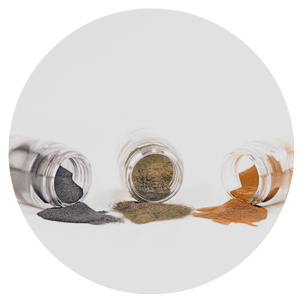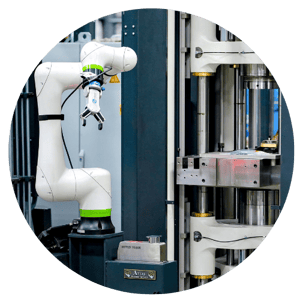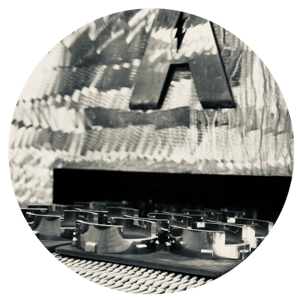
What is a Powder Metal Gear?
![]()
A powder metal gear is created through powder metallurgy – a process where powdered metal is compacted into shape using precision tooling, then sintered (heat-treated) to fuse the particles together. This method allows gears to be produced to near-net or net shape, often requiring little to no secondary machining. The result? Faster production times, lower costs, and consistent quality compared to traditional machining.
.png?width=400&height=400&name=Website%20Images%20500%20X%20500%20(55).png)
Key Benefits of Powdered Metal Gears
![]()
Manufacturers often choose powder metallurgy (PM) gears due to their ability to deliver high performance, operational efficiency, and design versatility. PM gears offer lower tooling costs, support production at any volume, and ensure consistent reproducibility. Design flexibility also makes PM gears an attractive solution for a wide range of applications.
Some other key advantages include:
- Tight Tolerances and Dimensional Accuracy: Powder metallurgy allows for tight tolerances, dimensional accuracy, and consistency, accommodating all production volume requirements.
- Cost-Effectiveness: High material utilization makes powdered metal a cost-effective choice. Producing components to tight tolerances often eliminates or reduces the need for additional operations, saving both time and costs.
- Eco-Friendly Process: Powdered metal is a green process with low energy usage and minimal scrap, making it more economical than standard machining, casting, or other metal-forming technologies.
- Optimized Performance: Material selection for gears allows for optimization of the component’s performance for its intended application with little variation in the manufacturing process.
Industries & Applications for PM Gears
![]()
Powdered metal gears are used in various industries where durability, cost efficiency, and performance matter most:
Industries: Appliances. Automotive, Medical Device, Power Tools & Equipment, Lawn & Garden
Gear Types: Spur, Helical, Bevel / Spiral Bevel, Pinion, Rack, Gear CombinationsAdditional Benefits of Using PM for Gears
![]()
Powder Materials for Structural Applications
![]()
Atlas offers a wide range of powder metallurgy components and materials to suit different applications:
Common Materials for Gear Production:
- Iron-Nickel and Nickel Steel: Admixtures of elemental iron, nickel, and graphite (when required) powders. These materials provide heat-treatable structural parts with strength, wear resistance, and impact properties.
- Prealloyed Steel: Developed from pre-alloyed low-alloy steel powders with nickel, molybdenum, manganese, and chromium as alloying elements. Used for components requiring heat treatment to increase strength and wear resistance.
- Hybrid Low-Alloy Steel and Diffusion-Alloyed Steel: Other powders used for specific applications.
Sinter Hardened Steel:
- Ideal for components requiring high strength, wear resistance, and tight tolerances.
- Hardened during the sintering process, providing improved dimensional control, cleanliness, and reduced processing steps compared to other heat treatment options.
- Note: Sinter-hardened materials are not easily machined.

Powder Metal Process
![]()
We use a proven, efficient process to produce PM gears that meet your exact requirements:
.png?width=300&name=Website%20Images%20500%20X%20500%20(49).png)
Collaborative review of your new part design or an evaluation of a potential conversion to powder metal for an existing part

Selecting the best powder or powder blend for durability, reliability, and accuracy

Compacting the metal powder to precise specifications under controlled pressure

Heating or "Sintering" to create a permanent form
Powder Metal Design Specifications
![]()
At Atlas, our team of skilled engineers brings extensive industry experience and knowledge to guide you through every stage of your structural component requirements. From weight to shape, our flexibility is our expertise. We design and manufacture components with the following specifications:
- Weight: 453.59 grams (1 lb) to 1360.78 grams (3 lbs)
- Diameter: 0.32 cm (0.125”) to 12.7 cm (5”)
- Length: 0.635 cm (0.25”) to 3.81 cm (1.5”)
- Shapes: Structural, spherical, flanged
Our advanced molding, sintering, and sizing capabilities, combined with a robust quality metric system, enable us to handle parts of all sizes and complexities. Powdered metallurgy, an economical and eco-friendly manufacturing option, minimizes material waste and reduces costs.
.png?width=500&height=300&name=Website%20Images%20500%20X%20300%20(4).png)
Need a Solution?
Ask Us a Question
Contact Information
Mailing Address
125 Tom Mix Dr.
P.O. Box P
DuBois, PA 15801
USA
Phone
Fax
Testimonial
"Our Engineering team works directly with Atlas Pressed Metals to achieve our company goals. Atlas is always very helpful, gives us on-time delivery and the sales reps are always willing to research to get answers for our needs.”
- Amanda S., Associate Buyer | Healthcare Industry

.png?width=300&name=Webpage%20Background%20(4).png)
